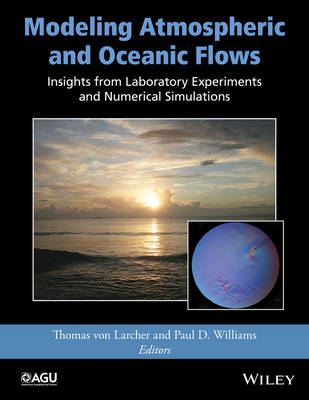
Modeling Atmospheric and Oceanic Flows
American Geophysical Union (Verlag)
978-1-118-85593-5 (ISBN)
Topics pertaining to atmospheric science, climate physics, physical oceanography, marine geology and geophysics
Overview of the most advanced experimental and computational research in geophysics
Recent developments in numerical simulations of atmospheric and oceanic fluid motion
Unique comparative analysis of the experimental and numerical approaches to modeling fluid flow
Modeling Atmospheric and Oceanic Flows will be a valuable resource for graduate students, researchers, and professionals in the fields of geophysics, atmospheric sciences, oceanography, climate science, hydrology, and experimental geosciences.
Thomas Gerd Von Larcher is a researcher in the Department of Mathematics and Computer Sciences, Institute for Mathematics at Free University, Berlin, Germany. He completed his doctorate in Engineering Technology. He has authored a few research articles and book chapters. His research interests include finite element method, fluid mechanics, computational fluid dynamics, computational physics, heat transfer, oceanography, fluid flow, numerical modeling. Paul D Williams is a Royal Society University Research Fellow at the University of Reading, in the Department of Meteorology and the National Centre for Atmospheric Science. He is at the Readership grade. He has authored over 80 research articles including a recent publication in Nature Climate Change. His research interests include studying the atmosphere and ocean, and their role in weather and climate, using mathematical and numerical models and laboratory experiments. He is also currently the Editor of Geophysical Research Letters.
Contributors vii Preface xi
Acknowledgments xiii
Introduction: Simulations of Natural Flows in the Laboratory and on a Computer 1
Paul F Linden
Section I: Baroclinic-Driven Flows
1 General Circulation of Planetary Atmospheres: Insights from Rotating Annulus and Related Experiments
9
Peter L Read, Edgar P Pérez, Irene M Moroz, and Roland M B Young
2 Primary Flow Transitions in the Baroclinic Annulus: Prandtl Number Effects 45
Gregory M Lewis, Nicolas Périnet, and Lennaert van Veen
3 Amplitude Vacillation in Baroclinic Flows 61
Wolf-Gerrit Früh
Section II: Balanced and Unbalanced Flows
4 Rotation Effects on Wall-Bounded Flows: Some Laboratory Experiments 85
P Henrik Alfredsson and Rebecca J Lingwood
5 Altimetry in a GFD Laboratory and Flows on the Polar β-Plane 101
Yakov D Afanasyev
6 Instabilities of Shallow-Water Flows with Vertical Shear in the Rotating Annulus 119
Jonathan Gula and Vladimir Zeitlin
7 Laboratory Experiments on Flows Over Bottom Topography 139
Luis Zavala Sansón and Gert-Jan van Heijst
8 Direct Numerical Simulations of Laboratory-Scale Stratified Turbulence 159
Michael LWaite
Section III: Atmospheric Flows
9 Numerical Simulation (DNS, LES) of Geophysical Laboratory Experiments: Quasi-Biennial Oscillation (QBO) Analogue and Simulations Toward Madden–Julian Oscillation (MJO) Analogue 179
Nils PWedi
10 Internal Waves in Laboratory Experiments 193
Bruce Sutherland, Thierry Dauxois, and Thomas Peacock
11 Frontal Instabilities at Density–Shear Interfaces in Rotating Two-Layer Stratified Fluids 213
Hélène Scolan, Roberto Verzicco, and Jan-Bert Flór
Section IV: Oceanic Flows
12 Large-Amplitude Coastal Shelf Waves 231
Andrew L Stewart, Paul J Dellar, and Edward R Johnson
13 Laboratory Experiments With Abrupt Thermohaline Transitions and Oscillations 255
John A Whitehead
14 Oceanic Island Wake Flows in the Laboratory 265
Alexandre Stegner
Section V: Advances in Methodology
15 Lagrangian Methods in Experimental Fluid Mechanics 279
Mickael Bourgoin, Jean-François Pinton, and Romain Volk
16 A High-Resolution Method for Direct Numerical Simulation of Instabilities and Transitions in a Baroclinic Cavity 297
Anthony Randriamampianina and Emilia Crespo del Arco
17 Orthogonal Decomposition Methods to Analyze PIV, LDV, and Thermography Data of Thermally Driven Rotating Annulus Laboratory Experiments 315
Uwe Harlander, Thomas von Larcher, Grady BWright, Michael Hoff, Kiril Alexandrov, and Christoph Egbers
Index 337
| Erscheint lt. Verlag | 20.1.2015 |
|---|---|
| Reihe/Serie | Geophysical Monograph Series |
| Sprache | englisch |
| Maße | 225 x 287 mm |
| Gewicht | 1116 g |
| Themenwelt | Naturwissenschaften ► Geowissenschaften ► Geologie |
| Naturwissenschaften ► Geowissenschaften ► Geophysik | |
| Naturwissenschaften ► Geowissenschaften ► Hydrologie / Ozeanografie | |
| Naturwissenschaften ► Geowissenschaften ► Meteorologie / Klimatologie | |
| Technik ► Umwelttechnik / Biotechnologie | |
| ISBN-10 | 1-118-85593-0 / 1118855930 |
| ISBN-13 | 978-1-118-85593-5 / 9781118855935 |
| Zustand | Neuware |
| Haben Sie eine Frage zum Produkt? |
aus dem Bereich


